Appearance and Design
The Samsung 245T takes the traditional approach when it comes to appearance. The frame is a glossy black plastic with a matte black stand. Some might go as far as calling the stand clunky looking -- it reminds us of the original Dell 2405FPW stand -- but it does everything that's required. The only truly noteworthy omission is that there is no cable management system at all, so the cables just hang loose off the back of the monitor -- nothing a few zip-ties won't fix, if that's a serious concern.
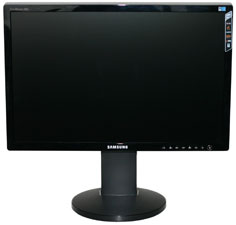 |
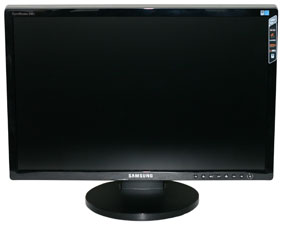 |
At the bottom right of the LCD, there are six buttons for accessing the on-screen display (OSD). Skipping the power button at the far right, which functions exactly as you would expect, the left button is a shortcut for enabling/disabling MPA. MPA stands for "Motion Picture Acceleration" and enabling it hopes to improve pixel response times. We'll find out later if it actually makes any noticeable difference in gaming as well. The second button brings up the main menu, and the next two buttons navigate through the menus. Pressing the menu button also exits out of submenus, while the fifth button (Source) acts as an enter button. When no other menus are active, the third button is a shortcut to cycle through the seven available color modes: Custom, Text, Internet, Game, Sports, Movie, and Dynamic CR. The fourth button also functions as a quick access to brightness levels, and the source button switches between available inputs -- note that if nothing is connected to an input, you can't switch to it without going through the full OSD menu. The Auto button is only useful in analog modes, where it will auto-adjust the screen size and centering, and the final PIP button turns on/off picture-in-picture.
 |
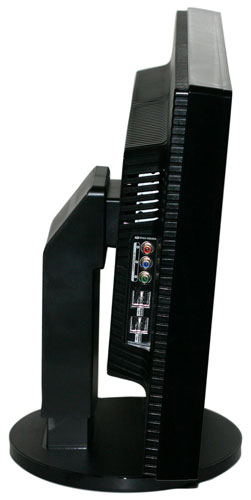 |
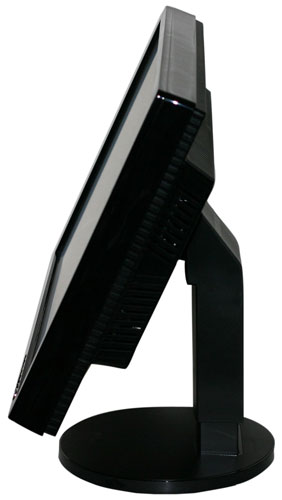 |
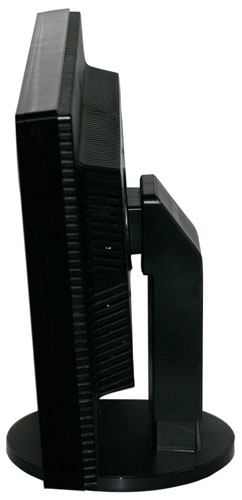 |
As mentioned earlier, the 245T supports the usual assortment of tilt, pivot, rotate, and height adjustment functions. You can see the range of motion available in the above images.
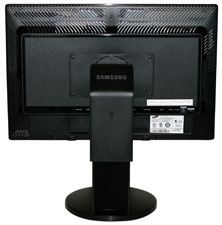 |
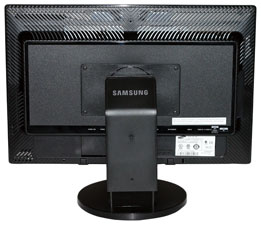 |
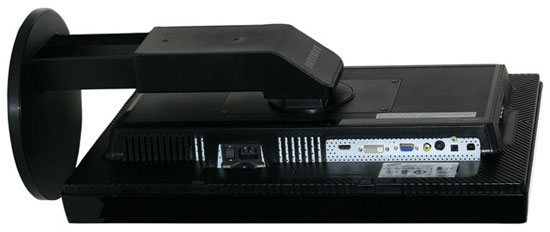 |
Most of the input ports all face downwards on the back of the display. The exception is the component input ports, which are on the left side of the display next to the four USB ports.
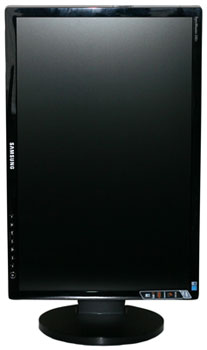 |
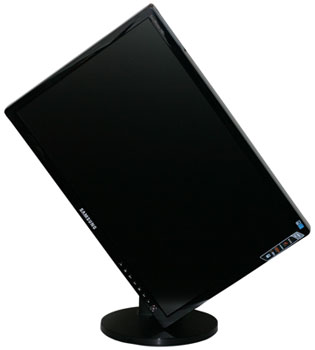 |
One nice feature of the stand is that it does allow you to raise the panel high enough that it can easily rotate into portrait mode. With some LCDs, we have found that you have to tilt the panel backwards as well as raising it to maximum height before you can rotate the display. If you find yourself frequently using portrait mode, the Samsung 245T would be a very good choice. Note also that the lack of cable management makes it easier to pivot the display.
We created a gallery showing all of the OSD menus and submenus, which you can access below. Most of the OSD functions are straightforward, but there are a few items worth pointing out.
First, there are multitudes of color adjustment options available. Not only can you adjust RGB levels, but you can also tweak hue and saturation via six color controls. We tend to find that amount of control more overwhelming than anything, but it's easy enough to ignore it and if you actually need such functionality it's there. Unfortunately, the second noteworthy item is a black mark; panel resolution scaling only offers two options: Wide or 4:3. "Wide" would be more appropriately named "stretch", as it will attempt to stretch any resolution to fill the entire screen -- without regards to aspect ratio. 4:3 on the other hand will fit any resolution into a 4:3 aspect ratio -- including 16:9 and 16:10 aspect ratios, even digital ones. What this all means is that sticklers who want 16:9 films not stretched vertically will be out of luck; similarly, people who connect an Xbox 360 or PS3 may be disappointed with the slightly stretched widescreen resolutions. What's missing from the scaling options are 1:1 (i.e. no stretch at all, giving black borders on all sides at lower resolutions) and proportional scaling (i.e. a 720p input would scale to fill 1920x1080, leaving black borders on the top and bottom edges) -- both of which are found on competing LCDs.
Update: The aspect ratio options are similar to what we found on the Samsung 2493HM when using the other input sources. In other words, 1:1 stretch is available on VGA connections. We no longer have the LCD, so we can't test the other inputs, but you can read the Samsung 2493HM review for more details.
















60 Comments
View All Comments
Deusfaux - Thursday, February 7, 2008 - link
I thought Samsung monitors had a 16:9 scaling mode?JarredWalton - Thursday, February 7, 2008 - link
This one doesn't... other Samsung displays might. See the OSD image gallery for details. The only options are "Wide" (fill the whole screen) and "4:3". That means that 5:4 resolutions (1280x1024) will also be distorted no matter what you do. I don't think the minor stretch of 16:9 to 16:10 is terrible, but some people care more about that than I do. Again, though, this is only an issue on non-PC use (or if your drivers don't allow you to correct the scaling).hotdogandchips - Thursday, February 7, 2008 - link
Jarred, can you tell us when the NDA regarding the 2408WFP expires by any chance? ;0JarredWalton - Thursday, February 7, 2008 - link
LOL... actually, no, I can't. Funny thing is that the date isn't set in stone just yet either, which is part of the reason I can't say. It's supposed to be this month, based on what I heard at CES, but it might get moved to early March?AcAuroRa - Thursday, February 7, 2008 - link
According tohttp://www.samsung.com/us/system/consumer/product/...">http://www.samsung.com/us/system/consum.../C070096...
... its a TN.... bah I'm confused -_-.. is it a TN or a PVA?
I actually own a w2408... and I actually like the thing -_-;;...but if there can be some facts straightened out I might go and get a 245T off the 'Egg as it is currently on sale for $650...
JarredWalton - Thursday, February 7, 2008 - link
See above post... the unit I reviewed is most assuredly an S-PVA panel. I believe the PDF is simply erroneous.bobo51 - Thursday, February 7, 2008 - link
I am confused.The article identifies the 245T as having a PVA panel. But I just went to the Samsung website and in their specification PDF for the 245T the panel is stated to be a TN.
Is their website document incorrect?
JarredWalton - Thursday, February 7, 2008 - link
I can absolutely state that the 245T LCD I have is S-PVA (based on how it looks from various angles), and Samsung told me it was S-PVA before I received it. http://www.samsung.com/us/system/consumer/product/...">This states otherwise, so I guess someone just put the wrong information in there. The other possibility is that there are different LCD panels in some of the 245T displays... hopefully not.Most companies do not make a point of stating what sort of technology their panels use. While I can understand that on TN panels, I'd think anyone using a PVA or IPS panel would want to crow about it. Kudos to Samsung for at least putting information on all of their displays in the PDF files; now they just need to make sure the data is correct. :)
I'm going to email my Samsung contact about this and see if there's just an error in the PDF that they can correct.
XrayDoc - Thursday, February 7, 2008 - link
I was all excited about this new display until I read about the limited scaling choices. I can't believe they didn't include a 1:1 or pixel to pixel option! Not everyone has a triple SLI video card setup that can run Crysis well at 1920 x 1200. I'd much prefer to run the game at a lower resolution with black borders and have the "pixels" look sharp, as opposed to stretching the non native resolution to fill the screen and look blurry! Plus automatically stretching 16:9 aspect sources vertically to fill the 16:10 screen is just plain ludicrous. Most people can notice when the aspect ratio is displayed incorrectly. What happens with a 2.35:1 ratio DVD? Does that also get stretched vertically so that you dont' see any black bars at the top or bottom? This single design flaw is a definite deal breaker for me. I hope the upcoming new models from Dell, etc. don't have this same design flaw.yyrkoon - Friday, February 8, 2008 - link
The big question would be; 'why do you need a 24" LCD to play Crysis?' For me personally I cannot see the need for anything much more than a 19" LCD(a good one at that) for gaming. This making current title fly on my C2D system with a 7600GT, and it draws way less power than one of the current higher end cards. Granted I probably wouldnt mind using a 8600 or something that draws slightly more power, and has DirectX 10 capabilities, but I wont go out of my way just yet to purchase another card, especially since I am still using XP Pro.Also I'm noticing complaints about input lag ? I would think this would be an image retouching LCD which doesnt require fast screen refreshes. You can buy cheap fast LCDs that will play games just fine(all day long).